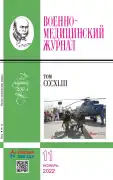Modern features of the diagnosis and treatment of olfactory disorders (literature review)
- Authors: Sokolov D.E.1, Pitik V.I.1, Kot N.N.1
-
Affiliations:
- Consulting and Diagnostic Center of the General Staff of the Armed Forces of the Russian Federation
- Issue: Vol 343, No 11 (2022)
- Pages: 53-58
- Section: Treatment and prophylactic issues
- URL: https://journals.eco-vector.com/0026-9050/article/view/629743
- DOI: https://doi.org/10.52424/00269050_2022_343_11_53
- ID: 629743
Cite item
Abstract
In the practice of otorhinolaryngology, the diagnosis and treatment of olfactory disorders play an important role. In modern conditions, introducing new technologies, changes in the environment, the realities of the COVID-19 pandemic have led to the emergence of features of the occurrence, prevention and treatment of this pathology. The article summarizes current information about the anatomy and physiology of the human olfactory analyzer, pathogenesis, diagnosis and treatment of olfactory disorders. The features and difficulties in the work of otorhinolaryngologists and other specialists in helping patients with olfactory dysfunction are analyzed. The question of the possibilities of diagnosing and treating olfactory disorders in the COVID-19 pandemic is discussed. It is concluded that there is no convincing data on the pathogenesis of most olfactory disorders, and therefore the effectiveness of the correction of this pathology remains low, and this problem requires further study and solution.
Keywords
About the authors
D. E. Sokolov
Consulting and Diagnostic Center of the General Staff of the Armed Forces of the Russian Federation
Author for correspondence.
Email: nickkot@gmail.com
Russian Federation, Moscow
V. I. Pitik
Consulting and Diagnostic Center of the General Staff of the Armed Forces of the Russian Federation
Email: nickkot@gmail.com
Russian Federation, Moscow
N. N. Kot
Consulting and Diagnostic Center of the General Staff of the Armed Forces of the Russian Federation
Email: nickkot@gmail.com
Russian Federation, Moscow
References
- Воячек В.И. Избранные вопросы военной оториноларингологии: Руководство для слушателей Военно-медицинской академии и военных врачей. – Л., 1934. – 196 с.
- Домрачева А.А., Офонькин В.Ю., Савченков Ю.И. и др. Способ проведения пороговой ольфактометрии / Патент на изобретение 2169364 C1 от 20. 06. 2001 г. URL: https://patenton.ru/patent/RU2169364C1 (дата обращения: 02.09.2022 г.).
- Малец Е. Нарушение обоняния и вкуса на фоне COVID-19 // Медицинский вестник – информационный портал медработников Беларуси.18.02.2021. URL: https://medvest nik.by/konspektvracha/ (дата обращения: 02.09.2022 г.).
- Пономарева Т.А. Обонятельные нарушения при болезни Паркинсона: Автореф. дис. ... канд. мед. наук. – М.: ФГБНУ «Научный центр неврологии», 2016. – С. 24–31.
- Aiba T., Sugiura M., Mori J. et al. Effect of zinc sulfate on sensorineural olfactory disorder // Acta Otolaryngol. – 1998. – N 118. – P. 202–204.
- Boesveldt S., Postma E.M., Boak D. et al. Anosmia. A Clinical Review // Chemical Senses. – 2017. – Vol. 42. – P. 513–523.
- Henkin R.I., Schecter P.J., Friedewald W.T. et al. A double blind study of the effects of zinc sulfate on taste and smell dysfunction // Am. J. Med. Sci. – 1976. – Vol. 272, N 3. – P. 285–299.
- Hummel T., Whitcroft K.L., Andrews P. et al. Position paper on olfactory dysfunction // Rhinology. – 2017. – Vol. 54, suppl. 26.
- Kim D.H., Kim S.W., Hwang S.H. et al. Prognosis of olfactory dysfunction according to etiology and timing of treatment. // Otolaryngol. Head Neck Surg). – 2017. – Vol. 156, N 2. – P. 371–377.
- Konstantinidis I., Tsakiropoulou E., Constantinidis J. Long term effects of olfactory training in patients with postinfectious olfactory loss // Rhinology. – 2016. – Vol. 54, N 2. – P. 70–175.
- Lechien J.R., Chiesa Estomba C.M., De Siati D.R. et al. Olfactory and gustatory dysfunctions as a clinical presentation of mild to moderate forms of the coronavirus disease (COVID-19): a multicenter european study // European Archives of Oto-Rhino-Laryngology – 2020 – Vol. 277. – P. 2251–2261.
- Majid A. Human olfaction at the intersection of language, culture, and biology // Trends in Cognitive Sciences. – 2021. – Vol. 25, N 2. – P. 111–123.
- Mullol J., Alobid I., Mariсo-Sбnchez F. et al. Furthering the understanding of olfaction, prevalence of loss of smell and risk factors: a population-based survey // BMJ Open. – 2012. – Vol. 2, N 6. URL: https://bmjopen.bmj.com/content/2/6/e001256 (дата обращения: 02.09.2022 г.).
- Nguyen T.P., Patel Z.M. Budesonide irrigation with olfactory training improves outcomes compared with olfactory training alone in patients with olfactory loss // Int. Forum Allergy Rhinol. – 2018 – Vol. 8, N 9. – P. 977–981.
- Poletti S.C., Michel E., Hummel T. Olfactory training using heavy and light weight molecule odors // Perception. – 2017 – Vol. 46, N 3–4. – P. 343–351.
- Qiu Ch., Cui Ch., Hautefort Ch. et al. Olfactory and gustatory dysfunction as an early identifier of COVID-19 in adults and children: an international multicenter study // Otolaryngol. Head Neck Surg. – 2020. – Vol. 163, N 4. – P. 714–721.
- Quint C., Temmel A.F.P., Hummel T., Ehrenberger K. The quinoxaline derivative caroverine in the treatment of sensorineural smell disorders: a proof-of-concept study // Acta Otolaryngol. – 2002 – Vol. 122, N 8. – P. 877–881.
- Stenner M., Vent J., Huttenbrink K.B. et al. Topical therapy in anosmia: relevance of steroid-responsiveness // Laryngoscope. – 2008 – Vol. 118, N 9. – P. 1681–1686.
Supplementary files






